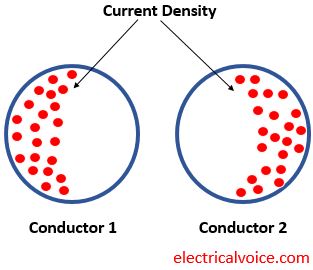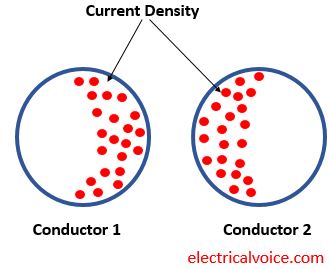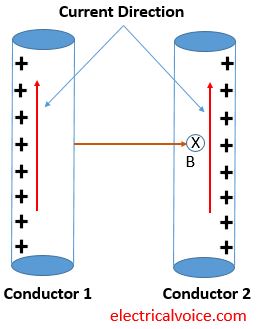In this article, we will learn Proximity effect that occur in conductors.
What is Proximity Effect?
Suppose two or more conductors carrying AC current are placed near each other. Each conductor is producing its varying magnetic field. When this varying magnetic field is linked with other current carrying conductors then the distribution of current in each conductor is affected due to the varying magnetic field.
The varying magnetic field produced by alternating current induces eddy currents in the adjacent conductors.
When the nearby conductors have AC current in the same direction then the current will concentrate at the farthest side of the conductors. This is shown in figure 1. Dotted is the current.

When the nearby conductors have AC current in the opposite direction then the current will concentrate on the nearest side of the conductors. This is shown in figure 2. Dotted is the current.

This phenomenon of distribution of current in the presence of nearby conductors is called as proximity effect.
What is the Cause of Proximity Effect?
The main reason for proximity effect is a production of a magnetic field in the surrounding of a current carrying conductor. As we know that a current carrying conductor produces the magnetic field in its surrounding as per the Biot-Savart Law. When this magnetic field links with the adjacent conductor, it gives rise to a circulating or eddy current in it. Because of this eddy current, the current distribution on the nearby conductor becomes non-uniform. This leads to additional resistance to the flow of current in the nearby conductor. Hence due to proximity effect, the net AC resistance of conductor increases. To better understand the proximity effect, let us consider figure 3.

The above figure shows two conductors carrying current in the same direction. The magnetic field created by conductor 1 will link with conductor 2. Similarly, the magnetic field created by conductor 2 will link with conductor 1.
The direction of magnetic field at any point B inside the conductor 2 will in going inside the plane of the page. Since the current is flowing in the upward direction, this means that free electrons are moving in the downward direction. The direction of the force on the free electrons due to the magnetic field of conductor 1 will be given by the cross vector product of velocity vector of electron and magnetic field vector at point B. From the cross vector product, the free electrons of conductor 2 will be drifted toward the inner surface i.e. toward conductor 1 and hence the current will flow mostly in the farthest surface of conductor 2.
The same reasoning when applied to conductor 1, it can be seen that current in the conductor 1 will mostly flow in the farthest surface. This effect of re-distribution of current on the conductor surface is called the proximity effect. This is so-called proximity effect as this is due to the effect of proximity (nearby) conductor.
What are the factors that affect proximity effect in conductors?
1. The proximity effect increases with increase in the frequency. This is the reason, this effect is not observed in case of DC. In case of DC, as the current is uniformly distributed over the entire cross-section of a conductor, the magnetic force on the free electrons inside the conductor is less prominent.
2. The effective resistance of the conductor is increased due to this effect.
2. More the diameter of the conductor, the more will be the proximity effect.
3. It also depends on the material of conductor. If the material is of ferromagnetic nature, proximity effect will be more.
4. It is more in case of a solid conductor. This is the reason, stranded or ACSR (Aluminum Core Steel Reinforced) conductors are used to reduce this effect.
